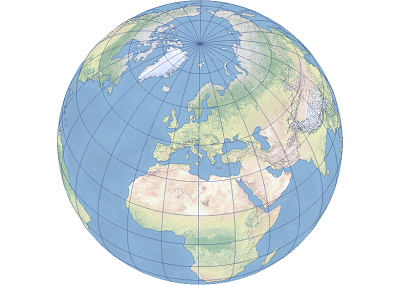Description
The local projection is a specialized map projection that does not take into account the curvature of the earth. The coordinates of the center of the area of interest define the origin of the local coordinate system. The plane is tangent to the spheroid at that point, and the differences in z-values are negligible between corresponding points on the spheroid and the plane. This map projection is the same as the orthographic projection but supported on ellipsoids and spheres, while the orthographic projection is supported on spheres only.
The local projection is designed for very large-scale mapping applications using local coordinate systems. It is available in ArcGIS Pro 1.0 and later and in ArcGIS Desktop 9.0 and later.

Projection properties
The subsections below describe the local projection properties.
Graticule
The local map projection is an azimuthal projection.
In the polar aspect, the meridians project as straight lines originating at the pole in the center. The angles between them are true. The parallels are shown as unequally spaced concentric circular arcs whose spacing decreases with the distance from the center. All graticule line intersections are 90°. The opposite pole cannot be projected. The graticule is symmetric across any meridian.
In the equatorial aspect, the equator and the central meridian are projected as two perpendicular straight lines. Two meridians, 90° east and west of the central meridian, project as a circle and represent the edge of the projection. The other meridians are complex curves whose spacing decreases away from the central meridian. All parallels are straight lines, perpendicular to the central meridian. Their spacing decreases away from the equator. Both poles project as points at the projection's edge. The graticule is symmetric across the equator and the central meridian.
In the oblique aspect, only the central meridian and antimeridian project as straight lines. Other meridians are semi-ellipses intersecting at the pole nearest to the center, which is projected as a point. The parallels are unequally spaced complete or partial ellipses whose spacing decreases away from the projection's center. The graticule is symmetric across the central meridian.
Distortion
The local projection is neither conformal nor equal area. Shapes, areas, distances, directions, and angles are all generally distorted. Only center of the map is free of distortion. Distortion increases significantly beyond about 1° from the origin.
Usage
Although the local projection can display almost an entire hemisphere, its practical usage should be limited to very large-scale mapping applications. The oblique aspect of this projection can be used as inset map, as a locator map, or for pictorial views of the Earth from space.
Limitations
The local projection is limited to a hemisphere and cannot display the whole world.
Parameters
Local parameters are as follows:
- False Easting
- False Northing
- Scale Factor
- Azimuth
- Longitude Of Center
- Latitude Of Center
Sources
Snyder, J. P. and Voxland, P. M. (1989). An Album of Map Projections. U.S. Geological Survey Professional Paper 1453.Washington, DC: United States Government Printing Office.
Thompson, M. M. (1966). Manual of Photogrammetry: Volume 1, 3rd Edition. America Society of Photogrammetry.